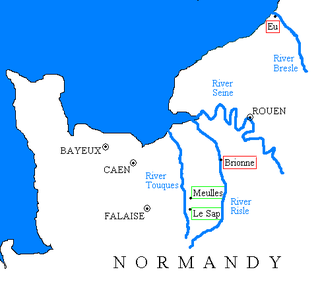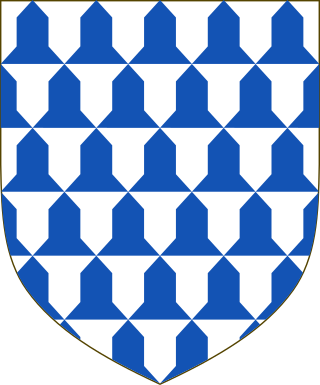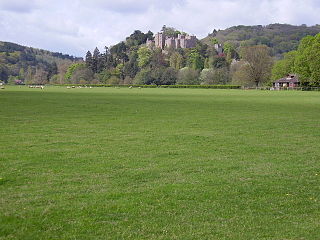Related Research Articles
William de Mohun of Dunster, Earl of Somerset, 2nd feudal baron of Dunster, was a favourite of Empress Matilda and a loyal supporter of her in the war against King Stephen, during which he earned the epithet of the "Scourge of the West".
William Malet, feudal baron of Curry Mallet in Somerset, was one of the guarantors of Magna Carta. In 1190, he accompanied King Richard the Lionheart on third crusade. While still on crusade in 1191, he took part in the Siege of Acre. Upon returning to England, he served as Sheriff of Somerset and Dorset in 1209. The precise nature of his relationship to an earlier William Malet is unknown.
Ivo Taillebois was a powerful Norman nobleman, sheriff and tenant-in-chief in 11th-century England.

Baldwin FitzGilbert was a Norman magnate and one of the 52 Devon Domesday Book tenants-in-chief of King William the Conqueror, of whom he held the largest fiefdom in Devon, comprising 176 holdings or manors. He was feudal baron of Okehampton, seated at Okehampton Castle in Devon.

William Brewer of Tor Brewer in Devon, was a prominent administrator and judge in England during the reigns of kings Richard I, his brother King John, and John's son Henry III. He was a major landholder and the founder of several religious institutions. In 1204, he acquired the feudal barony of Horsley in Derbyshire.

John de Beauchamp, 2nd Baron Beauchamp of Somerset was an English peer and was feudal baron of Hatch Beauchamp in Somerset.

Hatch Court in the parish of Hatch Beauchamp, in Somerset, England, is a grade I listed mansion built in about 1755 in the Palladian style with Bath Stone by the wool merchant John Collins to the design of Thomas Prowse. The site had been occupied since the mediaeval era by various forms of the manor house of the manor of Hatch, the caput of an important feudal barony first held by the Anglo-Norman de Beauchamp family in the 11th century.
Humphrey II de Bohun of Trowbridge Castle in Wiltshire and of Caldicot Castle in south-east Wales, 4th feudal baron of Trowbridge, was an Anglo-Norman nobleman, the third generation of the Bohun family settled in England after the Norman Conquest of 1066.
Newenham Abbey was a Cistercian abbey founded in 1247 by Reginald II de Mohun (1206–1258) on land within his manor of Axminster in Devon, England. The site of the ruined abbey is a short distance south-west of the town of Axminster.

In the kingdom of England, a feudal barony or barony by tenure was the highest degree of feudal land tenure, namely per baroniam, under which the land-holder owed the service of being one of the king's barons. The duties owed by and the privileges granted to feudal barons are not exactly defined, but they involved the duty of providing soldiers to the royal feudal army on demand by the king, and the privilege of attendance at the king's feudal court, the Magnum Concilium, the precursor of parliament.
William de Courcy, feudal baron of Stoke Courcy in Somerset, was an Anglo-Norman nobleman.

The feudal barony of Bampton was one of eight feudal baronies in Devonshire which existed during the mediaeval era, and had its caput at Bampton Castle within the manor of Bampton.

The Domesday Book of 1086 lists in the following order the tenants-in-chief in Devonshire of King William the Conqueror:

The feudal barony of Dunster was an English feudal barony with its caput at Dunster Castle in Somerset. During the reign of King Henry I (1100–1135) the barony comprised forty knight's fees and was later enlarged. In about 1150 the manors retained in demesne were Dunster, Minehead, Cutcombe, Kilton and Carhampton in Somerset, and Ham in Dorset.

Baron St Maur was a barony created by writ in 1314 for the soldier Nicholas de St Maur, of Rode in Somerset.

The feudal barony of Hatch Beauchamp or honour of Hatch Beauchamp was an English feudal barony with its caput at the manor of Hatch Beauchamp in Somerset. The site of the mediaeval manor house, to the immediate south of the ancient parish church of St John the Baptist, is today occupied by Hatch Court, a grade I listed mansion built in about 1755 in the Palladian style.
The feudal barony of Bradninch was one of eight feudal baronies in Devonshire which existed during the mediaeval era, and had its caput at the manor of Bradninch. One of the notorious barons was William de Tracy, who was one of the four knights who assassinated Thomas Becket, Archbishop of Canterbury, in Canterbury Cathedral in December 1170.
The feudal barony of Totnes was a large feudal barony with its caput at Totnes Castle in Devon, England. It was one of eight feudal baronies in Devonshire which existed in the mediaeval era. The first feudal baron was Juhel de Totnes, who is listed in the Domesday Book of 1086 as possessing 107 manors or other landholdings in Devon.

Walter FitzOther was a feudal baron of Eton in Buckinghamshire and was the first Constable of Windsor Castle in Berkshire, a principal royal residence of King William the Conqueror, and was a tenant-in-chief of that king of 21 manors in the counties of Berkshire, Buckinghamshire, Surrey, Hampshire and Middlesex, as well as holding a further 17 manors as a mesne tenant in the same counties.

Tor Mohun is a historic manor and parish on the south coast of Devon, now superseded by the Victorian sea-side resort of Torquay and known as Tormohun, an area within that town. In 1876 the Local Board of Health obtained the sanction of Government to alter the name of the district from Tormoham (sic) to Torquay.
References
- ↑ Sanders, I.J. English Baronies: A Study of their Origin and Descent 1086-1327, Oxford, 1960, p.114
- ↑ Sanders, I.J. English Baronies: A Study of their Origin and Descent 1086-1327, Oxford, 1960, p.114
- ↑ Sanders, I.J. English Baronies: A Study of their Origin and Descent 1086-1327, Oxford, 1960, p.114
- ↑ Dunning, Robert (2001). Somerset Monasteries. Stroud: Tempus. p. 21. ISBN 0-7524-1941-2.
- ↑ Cleveland, Duchess of (Catherine Powlett), The Battle Abbey Roll with some Account of the Norman Lineages, 3 vols., London, 1889
- ↑ Sanders, I.J. English Baronies: A Study of their Origin and Descent 1086-1327, Oxford, 1960, p.114
- 1 2 3 4 5 Hunt 1894.
- ↑ Dunning, Robert (1983). A History of Somerset. Chichester: Phillimore & Co. pp. 109–117. ISBN 0-85033-461-6.
- ↑ Domesday Book: A Complete Translation. London: Penguin, 2003. ISBN 0-14-143994-7 p.262-6
- ↑ Sanders, p.114
Attribution
![]() This article incorporates text from a publication now in the public domain : Hunt, William (1894). "Mohun, William de (fl.1066)". In Lee, Sidney (ed.). Dictionary of National Biography . Vol. 38. London: Smith, Elder & Co. p. 112.
This article incorporates text from a publication now in the public domain : Hunt, William (1894). "Mohun, William de (fl.1066)". In Lee, Sidney (ed.). Dictionary of National Biography . Vol. 38. London: Smith, Elder & Co. p. 112.